The Black Pennell is another one of those versatile wet fly patterns that is an essential addition to your fly box for fishing on rivers and stillwaters.
This classic wet fly pattern, developed by Henry Cholmondeley Pennell, has been catching trout on rivers and stillwaters for over 100 years.
The ones in my fly box have accounted for some lovely trout, grayling, sea trout, and even…
the surprise salmon.
This salmon was caught by mistake while fishing a #12 tungsten bead Black Pennell for trout on the River Ribble.
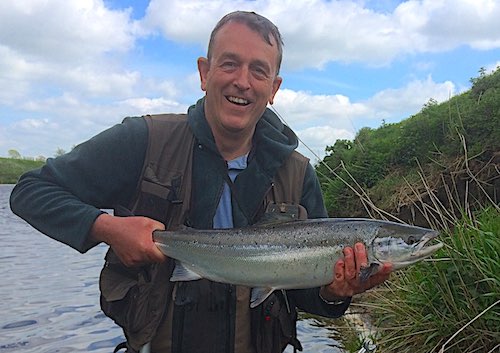
On stillwaters (lakes, lochs, reservoirs), it is good early in the season when midges are hatching.
So, let’s take a look at this classic fly pattern…
How to tie the Black Pennell fly
It’s a relatively simple fly to tie with a golden pheasant tippet tail, a silver ribbed black body, and a hackle. Therefore, a great fly for beginners to tie.
Tying material list:
- Hook – Kamasan B170 or 175 (sizes 16 to 12)
- Thread – Black 8/0
- Tail – Golden Pheasant tippet feather
- Body – Black floss
- Rib – Fine silver wire
- Hackle – Black Hen
Step-by-step tying instructions:

Step 1. Place the hook firmly in the vice and start the thread 1mm behind the eye. Wind the thread in touching turns down the hook shank, catching in a length of fine silver wire as you go
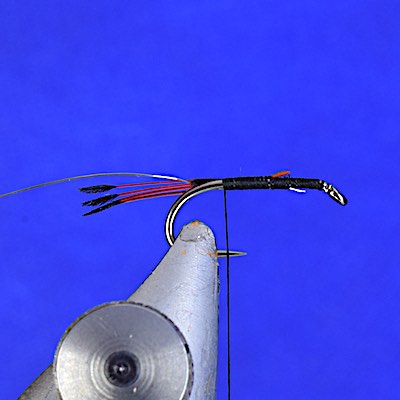
Step 2. Take 3 golden pheasant tippet fibres and tie them in before the hook bend. Make the tail length equivalent to that of the body.
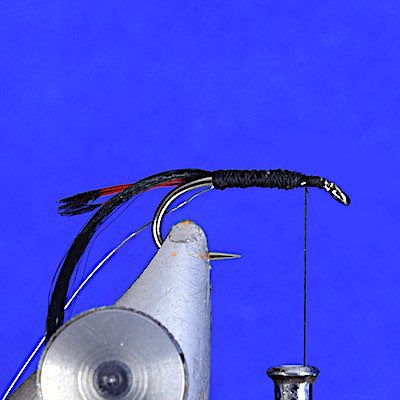
Step 3. Tie a short length of floss at the end of the body and then wind the thread towards the eye.
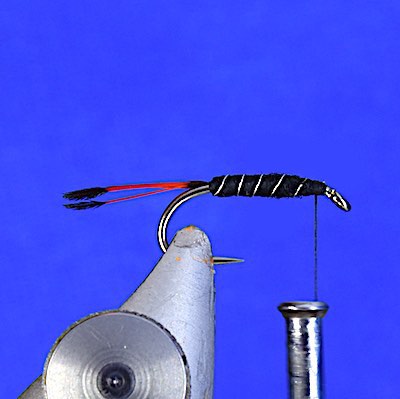
Step 4. Wind the floss up the hook shank to form a neat body. Then wind the silver wire up the body to form the rib.
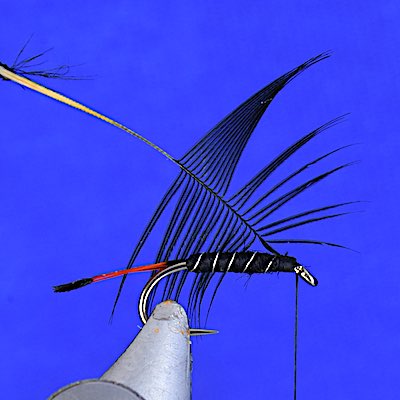
Step 5. Take a small black hen feather and tie it in by its tip.

Step 6. Wind the feather around the hook to form the hackle (ca. 2 turns). Finally, form the head with the thread, whip finish, and apply a drop of varnish.
If you are new to fly tying, you will find this instructional video by Davie very helpful.
In addition to the original Black Pennel pattern, I tie versions sporting a tungsten bead for fishing deeper in the water column. This is a neat way of adding weight to the fly while maintaining its slim profile.
The tungsten bead can be placed in front of the hackle to form the head of the fly. Alternatively, it can be positioned behind the hackle in the thorax area.
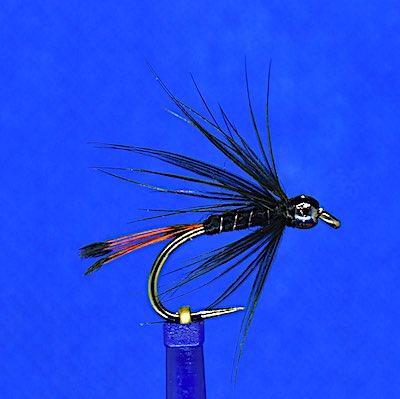

I’ve fished both versions of this weighted fly, which are equally effective, as far as I can tell.
How to fish the Black Pennell fly
On the Welsh Dee and River Ribble, I’ve found this classic wet fly works well on cold days when there’s no evidence of fly life activity.
My preference for the unweighted pattern (size 14 or 16) is to fish it on the top dropper of a team of wet flies. In this case, it’s probably taken for a midge, terrestrial flies, or pin-fry.
The other effective approach is to fish one of the tungsten bead versions on the point of a team of three wet flies. Especially when fishing wet flies across and downstream. In that situation, this weighted fly causes the other flies to fish deeper.

When wet fly fishing, I use a 9ft 5# rod, a floating line, and a 7ft 6X copolymer leader, which has been cut back to 5ft from the butt end. At the end of the leader, I tie on two 3ft lengths of 3 lb copolymer to form 2 droppers.
When fishing a single wet fly a simple 9ft 6X copolymer is a good choice.
On stillwaters (lakes, reservoirs, and lochs), the Black Pennell family of wet flies are often fished as a team from the bank or a drifting boat. The heavier flies are fished on the point or bottom dropper, while the unweighted pattern is fished on the top dropper.
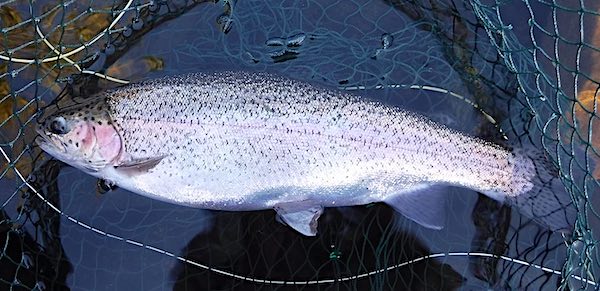
It’s often advantageous to tie a fly with a bushy hackle for the top dropper to cause a wake when retrieved and to get the trout’s attention.
For those anglers who fish for salmon and sea trout, try fishing BP flies that have been tied on larger hooks because I have caught salmon and sea trout using these flies. It’s probably a great alternative to fishing a stoat’s tail.
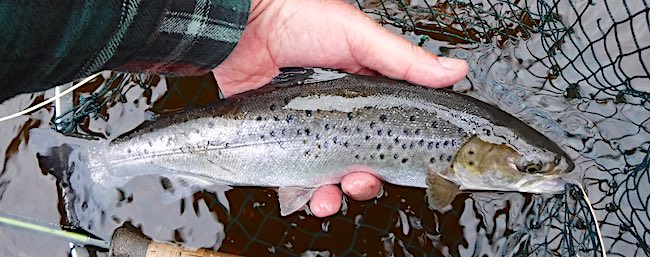
Finally, I hope this article stimulates you to tie the Black Pennell and test it on your local river or take a trip to fish the Welsh Dee at Llangollen, where the fly catches fish when other flies fail.
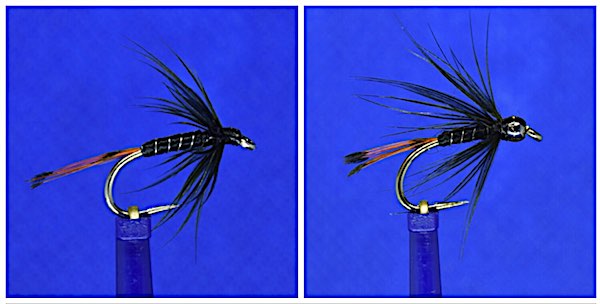
Great fly for sea trout .
Thanks Andrew informative as all ways
Hi Tim,
Yes and the odd salmon too.
Cheers, Andrew
Great article and a belter of a fly Andrew . Early season on Brenig , small and black does the trick normally doesn’t it ? Never used it on the Dee that much but as you did successfully, I’ve seen it being used for salmon on the Cumbrian Derwent , with the same results
Hi James,
Agree with you there. Very easy black fly to tie and will catch fish almost anywhere. A great low water summer salmon fly on the Dee.
Cheers, Andrew
Very incisive view of this classic thank you. Video of Dietrich Bohnhorst on YT picking up Salmon on his Irish rivers, I am surprised at how multi species oriented this fly can be!
Hi Chris,
Glad you enjoyed it and thanks for the feedback.
Also, thanks for the video reference. They have given me some ideas on fishing for salmon on the Welsh Dee, which I will be trying out this season.
Cheers, Andrew
A well known and effective pattern. We all should carry a few of these in our boxes!
Agree
excellant Andrew very nice piece
i enjoy using these flies
Hi Colin,
Thanks for the feedback, it’s great to hear you are enjoying this series of post.
Cheers, Andrew
Probably one of the most effective and straightforward flies to tie.Ive used it since I first fly fished..1974 and caught my first trout on it ,Cameron Reservoir ,Fife and use it still .Very useful when trout are taking buzzer as they surely will when we start in April.It’s a must have for waters such as Cow Green,Carsington and definitely that trip to the Highlands.
Hi Simon,
Thanks for your useful comments. I hope to have a fishing trip to the highlands this year and will be taking a few Pennells with me.
Cheers, Andrew
Thanks Andrew for such comprehensive tying instructions – another fantastic post
Hi Nigel,
It great to hear you are enjoying the post.
Thanks for the feedback.
Cheers, Andrew
Hi Andrew, I love fishing these historic patterns which are lethal ,far better than blobs etc, I also put a starling wing on one and then it’s a blue and black which is equally as good ,thanks xfor showing this fly.
My last post should say blae and black .
Hi Terry,
I’ve never fished the Blae & Black but will tie a few and test them out on the Welsh Dee.
Cheers, Andrew
Nice article I have just ordered myself 3 of 14 & 3 of 16 for my local river west & will try them out on my local reservoir will let you know I get on
Hi Neil,
Great to hear you enjoyed the post. It would be great to know how you get on with these flies.
Cheers, Andrew
Hi Andrew, the Black Pennell was probably one of the first flies I ever used when I started Fly Fishing nearly 60 years ago on the River Wye and has caught fish for more than a hundred years so it cannot be a bad fly. It seems to catch in all locations both river and still waters and has the right colour and size to suggest something of all insects. Thanks for your articles and keep them coming. Tight Lines.
Hi Ian,
Agree with all your comments. You can’t go wrong with a few black flies in your fly box when fishing for trout and grayling.
Tight lines, Andrew
Haven’t got any of these. But will have next time i get to the vice! Thanks for this enlightning article
Hi Paul,
Great to hear you enjoyed the article. Would be great to know how you get on with the weighted version.
Tight lines, Andrew
Just because its an old, traditional pattern, these rae still deadly. I love the weighted version and will tie up a few myself. Thanks Andrew, another great post.
Hi Charles,
Let me know how you get on with the weighted version.
Tight lines, Andrew
Thanks Andrew, so simple and so effective.
I love the tb version which I might try for grayling
Hi Steve,
It’s a great option when you want to fish it a little deeper and the grayling love it.
Tight lines, Andrew
Thanks Andrew.
Black pennel is a fly I’ve used for seat trout way back. It’s been neglected over the years. Your blog is a good reminder to get some tied. Enjoyed the article thank you.
George
Hi George,
Have to agree it’s a much underused fly but more often than not produces the goodies.
Tight lines, Andrew
Has anyone used the claret version of the Pennell? I’ve been told it works quite well on occasions.
Hi Steve,
I haven’t but will tie a few and give them a go to see how effective they are.
Thanks for the comment, Andrew